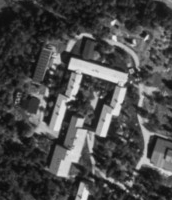Realtid.se, which broke the story last week of the censored Swedish “spy base” (HQ of FRA, “the National Defence Radio Establishment”), also read the Swedish blogger who found out that you can in fact purchase what appears to be an unretouched aerial image of the base from the website of Lantmäteriverket, the state GIS agency responsible for the censorship. In doing so, Lantmäteriverket appears to be breaking a law they have just been defending in the press.
So Realtid.se went and purchased the offending image, called up a spokesman at Lantmäteriverket, and had some fun. Translating a whole lot from the resulting article, in Swedish:
— Realtid.se: I have just bought a photo of FRA from your web site. Is it legal for you to publish such images?
— Lantmäteriverket’s spokesman: Yes it is.
— Realtid.se: Why then do you retouch Eniro’s images?
— Spokesman: Hm… Can I get back to you?
Realtid.se writes how Anders Wiik, deputy head of FRA, called back later, to explain that selling such images is nothing to be worried about. Sure, he says, there is a law against photographing such buildings, including from the air. But the images are not sufficiently detailed for it to be a cause for concern to them at FRA, he maintains. Wiik does admit, genially:
I am going to send your article to our head of security. It does all look a little inconsistent. And consistency is not always a strong suit of the Swedish civil service (“Myndighetsverige”).
A bit later, Lantmäteriverket’s head of security Michael Munter calls Realtid.se. (Munter is the person who last week explained to Realtid.se exactly why Eniro’s images needed to be painted over with trees). Munter assures them that in fact the image they purchased is retouched, just in a cleverer way:
In our image there are retouched areas, but not buildings. The secret objects are retouched, but in another way. It isn’t often that we retouch buildings.
So I too bought the official 1-meter resolution aerial image of the base and decided to have another (closer) look, comparing it to what Google Maps shows. Google Maps is far more detailed, and also appears to be much more recent. For example, there are new parking areas not seen on the bought image, and roads that have faded on Google Maps through disuse are still clearly in use on the bought image.
Both maps clearly show parabolas on the north end of the image. The only substantial difference I found anywhere on the base is one new building in Google Maps, around which the road has clearly been rerouted, and a parabola to the west. Check for yourself:


Snippet of same area, as sold by Lantmäteriverket (1-meter resolution)
Let’s not forget how all of this looks in Eniro (exact same area):

There is nothing missing from the official sold image that looks “retouched”. It’s merely an older image.
In my estimation, instead of coming clean, Michael Munter once again tried to pull a fast one on us. Ironically, because we cannot verify the trustworthiness of the image, there is no means for us to check if he is in fact telling the truth or simply covering up for a week of glib platitudes to the press. And the lack of accountability that comes with him being his own judge and jury in this respect drives home the whole point of why, in an open society, obfuscating censorship is worse than censoring honestly, for example by pixellating.